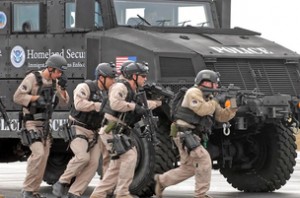On average, based on statistics that we received through the Freedom of Information Act, being involved in an operation in which there's gunfire is on average a monthly occurrence.
THORSEN: And what kind of other cases is this high-risk team normally working on? What's their usual area of focus?
BECKER: Well, there are really two main arms to Immigrations and Customs Enforcement. There's what they call homeland security investigations, and there is enforcement and removal operations. The homeland security part, as the name suggests, does complex investigations -- everything from drug trafficking and human smuggling to weapons proliferation and even intellectual property rights. They are the second largest contributor to the nationwide joint terrorism task force, which is run by the FBI. So they enforce a wide variety of laws, and in a number of situations in which they're executing a search warrant or trying to arrest someone, those could potentially be a dangerous situation.
The other arm is ICE engages in enforcement and removal operations, focussing on immigration enforcement, and in those cases they're also out often doing early-morning operations like the one in Petaluma. The immigration enforcement arm does what's called fugitive operations, where they're looking for people who may have been ordered out of the country but haven't shown up to be deported, or haven't shown up for a court appearance, or things like that.
Oftentimes the agency says they're focussed on going after people who have criminal records, who they believe should be removed from the country or have, in fact, been ordered removed from the country.
So, it's different sides of the house for them, but either side can find themselves in these kind of situations.
THORSEN: And this being in a mixed-residential neighborhood in the early morning hours -- is that a typical time and place to conduct this type of operation?
BECKER: I think location can vary, but certainly it's pretty typical that they're going to go in early in the morning when they've done their surveillance, they've gathered their intelligence and they believe that person is going to be at that location. Doesn't always work out that the person they're targeting is at that home. They've had instances where they've gone to the wrong house. But this is pretty common for ICE and even law enforcement in general.
THORSEN: Can you summarize some of the other recent incidents involving ICE agents?
BECKER: There have been a number of shootings recently involving ICE agents. Some of them are not related to work. There was a shooting Wednesday night in Los Angeles involving another homeland security investigation agent who was killed in his home. His 14-year-old son has been taken into custody, but details are pretty limited in that case.
Earlier this year, in Long Beach, there was a workplace shooting involving three agents. Two agents had gotten into a dispute, one agent with a supervisor. He shot his supervisor, and in turn another agent came in and shot and killed the first agent who had done the shooting.
And then there was a very high-profile case last year involving two Homeland Security investigations agents who were on assignment in Mexico who had been, essentially, ambushed at a roadblock in between Monterrey and Mexico City. One agent was killed in the shooting and another was injured.
ICE has roughly around 20,000 employees, give or take. About 13,000 of them are issued guns. So, again, this is law enforcement. It's an agency that, really on either side of the house, frequently comes in contact with a lot of people that the Obama administration has been very focussed on removing; what they call criminal aliens, who have criminal records and who have been ordered deported.
That has really been the focus of this administration -- to get them out of the country. And in those cases, sometimes people are in custody, and it's a pretty smooth transition or process to remove them. Other times, some individuals are on the lam, and they have to conduct operations like this.

